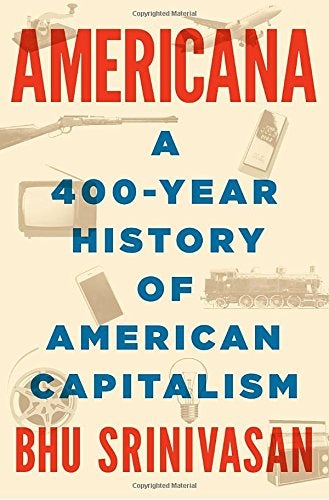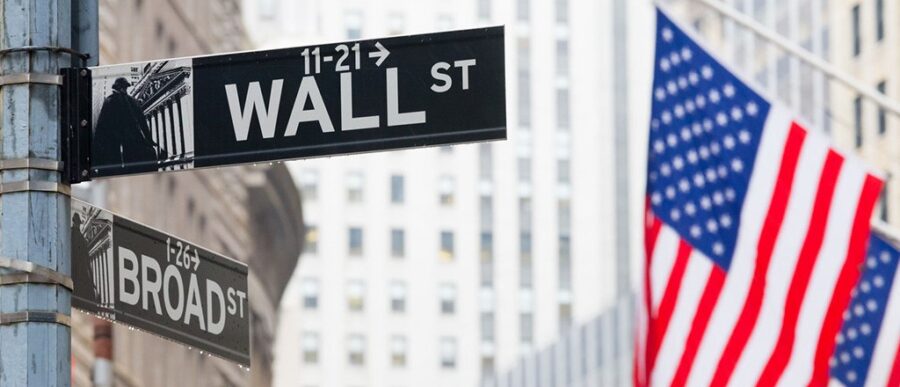 The United States has always been a beacon of hope for entrepreneurs and a powerhouse in the global economy. But how did it become that way? A new book by Bhu Srinivasan traces the complex journey of American capitalism to show how history influenced its development. Americana: A 400-Year History of American Capitalism looks at the evolution of capitalism from the first European settlers to the age of the internet. Srinivasan joined the Knowledge at Wharton show, which airs on SiriusXM channel 111, to talk about why he sees capitalism less as an ideology and more as a pragmatic system.
The United States has always been a beacon of hope for entrepreneurs and a powerhouse in the global economy. But how did it become that way? A new book by Bhu Srinivasan traces the complex journey of American capitalism to show how history influenced its development. Americana: A 400-Year History of American Capitalism looks at the evolution of capitalism from the first European settlers to the age of the internet. Srinivasan joined the Knowledge at Wharton show, which airs on SiriusXM channel 111, to talk about why he sees capitalism less as an ideology and more as a pragmatic system.
An edited transcript of the conversation follows.
Knowledge at Wharton: When you think about this, it’s important to examine capitalism from a historical perspective because there were elements of it even before the American Revolution.
Bhu Srinivasan: I think that’s central to how we should look at the American experience through the lens of economic motivations. That’s one of the things that I look to do. My family came here as immigrants from India. When you’re coming here from another democracy, you’re not necessarily coming for liberties and freedoms. Those things are certainly tremendous assets, but you’re coming for those economic motivations. I trace that back to the Mayflower and the Virginia Company [chartered by King James to set up a North American colony]. After all, it is a company, meaning that there’s a profit motive. You start peeling back the layers and see that they have shareholders and pro rata distributions and all of that.
Knowledge at Wharton: When you think about what is taught as American history, the business aspect isn’t always discussed.
Srinivasan: Exactly. You almost have to ask yourself a very basic question: How did a bunch of a persecuted religious separatists afford to charter a giant ship for a transatlantic voyage? If I were to tell you that 100 people in Central America who were looking to flee decided to charter a 737, you’d want to know how they were able to finance that. What did they expect to do when they got here? You can look at all the primary text. It’s so heavily detailed as to what the transactions were with their financiers. They were known as the merchant adventurers.
“I always think about democracy and capitalism as kind of the twin operating systems of America.”
Knowledge at Wharton: In the book, you take a look at some of the items that helped grow the American economy, specifically tobacco. I find it interesting that you can correlate history through these products.
Srinivasan: The device that I used was to explore American history as a series of next big things. I somewhat stumbled into that accidentally. In 1995, I was taking a freshman history class from acclaimed historian Richard White, who’s now at Stanford University. His assignment in the class was to trace our family’s history and connect it with American history. My family had been here since 1984, so there wasn’t much to connect except through economic themes.
We came to Buffalo, N.Y., and then eventually we made it out west when my mother joined a biotech company in Seattle. From 1995 onwards, we saw the next big thing of the internet in Seattle and Silicon Valley. My personal history influenced the lens through which I sought our own economic motivations in coming to this country — just the environment I was in, seeing how transformative some of these changes are and how fast it happens.
Knowledge at Wharton: Entrepreneurship has become bigger in the American vernacular in the last 20 years, but the concept dates back to the 1600s here. It’s one of the core tenets that United States was built on. Do you agree?
Srinivasan: Without question. I always think about democracy and capitalism as kind of the twin operating systems of America. I don’t see one existing without the other, at least in what we know of America to be today. I think that entrepreneurial activity in the Gilded Age was phenomenal. It’s phenomenal now as well, but I think it’s a very central aspect of the American DNA.
Knowledge at Wharton: The Civil War is a huge part of American history, and you go into the impact that slavery had on the economy. Where would this country have gone if the South had won the war?
Srinivasan: No question. [And] what would have happened to California? At that time, California was almost like Hawaii or Alaska. It really wasn’t ‘connected’ [via mass transit or communications] to any other American states. It had the Rocky Mountains. There was no telegraph that connected California to the Eastern Seaboard at the time the Civil War had started. There was no transcontinental railroad. Either you had to make it through land or go through Panama or Nicaragua or around South America. So, that’s very much a question also.
One of the other things that influenced my version of what led to the Civil War was this big bubble in slave prices. From the crash of 1857 all the way to the lead up, you had slave prices actually go up. After the Dred Scott decision in 1857 [where the Supreme Court ruled that Africans with slave ancestry cannot be U.S. citizens], you saw it go up. This dogma of markets being perfectly rational and efficient, I look at that with a skeptical eye because I’ve seen what happened with dot-com stocks in the late ’90s. Markets don’t price everything exactly perfectly. They do over time, but not necessarily in the moment. That was one of those times where slave prices were in this complete bubble. They were decoupled from cotton prices, and it made the South believe that the institution of slavery was worth a lot more than it ultimately turned out to be.
“Markets don’t price everything exactly perfectly. They do over time, but not necessarily in the moment.”
Knowledge at Wharton: Had the South won the war, would slavery and cotton have continued to be the key components of the U.S. economy?
Srinivasan: Without question. Before the Civil War, cotton was America’s largest export. In colonial America, tobacco was by far the largest export. Even though the North was industrializing, it wasn’t industrialized like England. The United States still imported iron for rails. It wasn’t self-sufficient in iron.
There’s a great book called Empire of Cotton: A Global History by Harvard historian Sven Beckert. He goes into how the Civil War factors very prominently in Egyptian history because the 1860s is when Egyptian cotton production went through the roof. Same thing in India, too. You can see a very strong correlation between the Union blockade of southern ports, when cotton couldn’t get out, and the new supply that came from Egypt and India.
Knowledge at Wharton: You also look at how World War I and World War II were a boon to manufacturing in the United States. It’s important to realize that wars have pushed economic growth here.
Srinivasan: Even before the United States entered the war in 1915 and 1916, American exports grew fairly substantially. Same thing in 1940 and 1941, because in the earlier war, the United States was a primary oil exporter at that time. Oil, steel, everything required for modern warfare was produced in the United States. Given the late entry of the United States into both wars, it allowed fresh resources, fresh materials, fresh troops. Industry became part of the military machine.
Knowledge at Wharton: How do you think wars affected some of the legacy companies that were not linked directly to the war effort? You bring up an interesting story about the Busch family, the Budweiser heirs. Prior to World War I, they used to throw parties every year for the Kaiser’s birthday.
Srinivasan: A number of factors come into that. One, you have obviously a lot of anti-German sentiment because of Lusitania, the British ship that was downed. On top of that, you had the 16th amendment, which gave you the income tax. During World War I, the federal government was able to rely on this brand new constitutional authority to be able to finance the war. Right before the income tax, the tariffs and the taxes on alcohol and tobacco were the primary ways that the federal government financed itself. But during World War I, that obviously shifted when the federal government discovered that income tax is a far superior revenue mechanism. That’s what allowed Prohibition to essentially happen, because the federal government is not reliant upon alcohol revenue.
Knowledge at Wharton: Why were the more recent wars in Korea and Vietnam not marked by economic growth?
Srinivasan: In President Dwight Eisenhower’s farewell address to the nation, he talked about the military industrial complex and lays out the case for it. Before, you could change an industry and transform it into a military production within six months, or a year. But with the rise of computers, technology, and research and development required during the Cold War, you really couldn’t have that happen. You had to have a very specific military industry. That’s one of the things that decoupled — there’s not necessarily a catalyst for industry being repurposed for warfare because you already have a specialized industry that’s always being prepared.
Knowledge at Wharton: The United States has this relationship between growth at the federal level compared with the states. Can you talk about that?
“American history is so complex and so fascinating, you never fail to run into those stories.”
Srinivasan: There’s this interesting pattern that every time there’s a war, the federal government gets much bigger in terms of its expenditures and doesn’t quite recede back to earlier levels. … You can see during the Civil War this big change in the magnitude and scale of government. It’s the same thing during World War I and World War II, and it doesn’t quite recede back. That’s the argument that Shelby Foote makes in Ken Burns’ The Civil War [a PBS documentary]. We went from an are to an is. It’s like America was a collection of states, and we would refer to ourselves as the United States are rather than the United States is. A lot of that forging of these disparate states is the rise of the federal government.
Knowledge at Wharton: Now we’re in the digital age, and it feels like we’re on a path to even greater economic growth in the years to come.
Srinivasan: You would think so, but where does that economic growth happen? Silicon Valley hasn’t missed a beat, but you’re seeing the election results from 2016 where it’s not a coincidence that Rust Belt states were the swing factor in the election results. I don’t think the answer’s quite clear-cut.
I think that previously the next big things in American history always created a lot of jobs. When there was movement into the suburbs, you had home construction that would create a lot of jobs. The worker could also participate as a consumer because he’s getting high wages when he’s building those homes. The next big thing for the past 35 years has decoupled that equation. I don’t think that the American worker can significantly contribute to iPhones, for instance, or to the internet. I think that’s the unsettling factor that you’re seeing manifest itself in many different ways.
Knowledge at Wharton: A lot of people would like to believe there will be another manufacturing boom in the United States to put people back to work. But that’s just not possible anymore.
Srinivasan: Yes, and we’ve had 45 years of very significant trade deficits that do not seem to be tightening. They seem to be widening. Trade deficits do not [ordinarily] masterly happen with first-world countries. It’s not a rule. Germany and Japan certainly do not have very large trade deficits, and they don’t even have oil. The United States not only has Silicon Valley, it also has enormous oil reserves. It’s always in the top three in terms of oil production. Considering that it still runs these very large trade deficits, I don’t know whether that’s necessarily the case that you cannot indeed start up manufacturing in this country. Germany has high wages and they certainly are able to do that.
“You have to strip away ideology from American capitalism and think about it as a very practical system.”
Knowledge at Wharton: Were there other stories that caught you off guard as you were researching the book?
Srinivasan: Many. Look at Gone With the Wind, for instance. That movie came out in late 1939 and was received with huge pageantry in the South. They had a parade, hundreds and thousands of people. I think it was a statewide holiday in Georgia. The mayor of Atlanta was hugely instrumental in coordinating the marketing. Yet [African-American] Hattie McDaniel, who plays Mammy in the movie, was not welcome at any of the events. At the same time, Americans are debating Hitler and what’s happening in Germany. It’s some of these stark and very striking parallels and contradictions that just come out at you. American history is so complex and so fascinating, you never fail to run into those stories.
Knowledge at Wharton: Are there stories that led you to a better understanding about the growth of the American economy?
Srinivasan: The central takeaway that I had– and this is largely driven by curiosity, the whole discovery process, the research process — is that you cannot think about American economic development as an ideology. You have to strip away ideology from American capitalism and really think about it as a very practical system.
Sometimes, it needs to be regulated where excesses need to be stripped away. Other times, it harnesses the creative energy of entrepreneurs in ways that you could not foresee. I think it’s just a complicated system, and I think that you have to look at it very pragmatically and utilize those forces very pragmatically. That’s what I’ve seen emerge, that it’s not an ideology. It’s democracy and capitalism combining and clashing and tempering themselves, and emerging in this very significant system.



